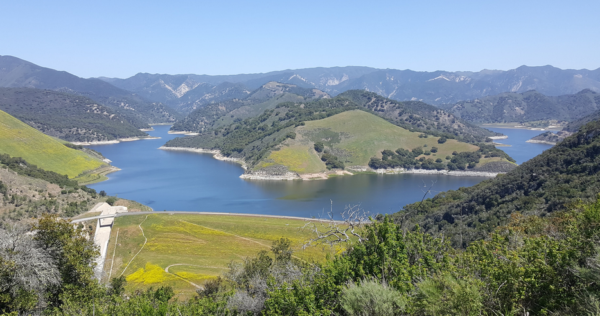A look at San Luis Obispo County rainfall totals, reservoir levels
May 27, 2025

Lopez Lake
By KAREN VELIE
Rainfall totals in San Luis Obispo County are slightly below average in most areas of the county with totals running between 66% to slightly over 100% average yearly rainfall, according to SLO County. After several years of heavy rains, local reservoir levels remain healthy.
Climate scientists track rain from July 1 through June 31.
Rainfall totals from July 1 through May 27, along with average yearly rainfall:
Arroyo Grande – 9.30 inches to date – average 14.09 inches
Atascadero – 9.22 inches to date – average 12.06 inches
Lopez Dam – 15,14 inches to date – average 18.48 inches
Los Osos – 11.96 inches to date – average 15.77 inches
Nipomo – 11.30 inches to date – average 12.62 inches
Oceano – 9.04 inches to date – average 12.26 inches
Paso Robles – 9.71 inches to date – average 14.08 inches
Rocky Butte – 34.91 inches to date – average 34.75 inches
San Luis Obispo – 12.81 inches to date – average 16.82 inches
San Simeon – 12.09 inches to date – average 15.12 inches
Santa Margarita – 13.13 inches to date – average 16.96 inches
Shandon – 6.57 inches to date – average 8.44 inches
Templeton – 9.39 inches to date – average 13.05 inches
Current Central Coast and major state reservoir levels:
- Santa Margarita Lake at 95,2%, SLO County
- Lake Nacimiento at 61%, SLO and Monterey counties
- Lopez Lake at 91.5%, SLO County
- Whale Rock Reservoir at 65%, SLO County
- Cachuma Lake at 86%, Santa Barbara County
- Gibraltar Reservoir 84%, Santa Barbara County
- Jameson Reservoir 98%, Santa Barbara County
- San Antonio Lake at 71%, Monterey County
- Oroville Dam 90%, Butte County
- Trinity Lake at 90%, Trinity County
- Don Pedro Reservoir at 90%, Mariposa County
- New Melones Lake at 83%, Calaveras County
- Shasta Dam at 96%, Shasta County
- San Luis Reservoir at 88%, Merced County






The comments below represent the opinion of the writer and do not represent the views or policies of CalCoastNews.com. Please address the Policies, events and arguments, not the person. Constructive debate is good; mockery, taunting, and name calling is not. Comment Guidelines